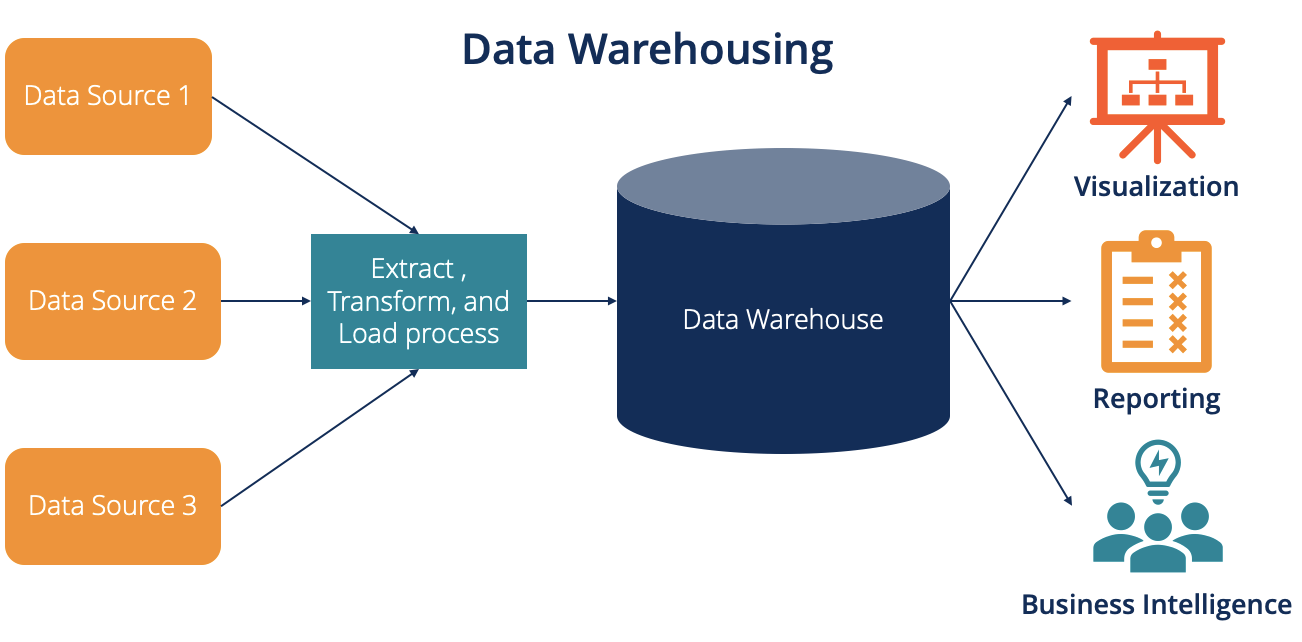Lecture 12
Data Preparation and Management
September 25, 2024
Technologies Used to Manage and Process Big Data
Technologies Used to Manage and Process Big Data
- Definition of Big Data
- Data sets so large and complex that traditional data management tools are inadequate.
- The Need for Advanced Technologies
- Emerging technologies are essential to manage, process, and analyze big data effectively.
- Overview of Topics
- Data Warehouses
- Extract, Transform, Load (ETL) Process
- Data Marts
- Data Lakes
- Hadoop
Technologies Used to Manage and Process Big Data
Challenges with Traditional Data Management
- Limitations
- Traditional software and hardware can’t handle the volume, velocity, and variety of big data.
- Impact
- Inability to store massive data volumes efficiently.
- Difficulty in processing and analyzing data in a timely manner.
- Solution
- Adoption of new technologies specifically designed for big data management.
Data Warehouses, Data Marts, and Data Lakes
Data Warehouses

- Definition
- A large database that holds business information from many sources across the enterprise.
- Purpose
- Supports decision-making processes by providing a comprehensive view of the organization’s data.
Data Warehouses, Data Marts, and Data Lakes
Data Warehouses Characteristics
| Characteristic | Description |
|---|---|
| Large | Holds billions of records and petabytes of data |
| Multiple Sources | Data comes from many internal and external sources via the ETL process |
| Historical | Typically contains data spanning 5 years or more |
| Cross-Organizational Access and Analysis | Data accessed and analyzed by users across the organization to support multiple business processes and decision-making |
| Supports Various Analyses and Reporting | Enables drill-down analysis, metric development, trend identification |
Data Warehouses, Data Marts, and Data Lakes
Data Warehouse Architecture
- Data Sources
- Internal Systems: Online transaction processing systems, customer relationship management, enterprise resource planning.
- External Systems: Social media, government databases, etc.
- ETL Process
- Extract, Transform, Load (to be discussed in detail).
- Data Storage
- Centralized repository optimized for query and analysis.
- Data Access
- Used by various departments for reporting, analysis, and decision-making.
Data Warehouses, Data Marts, and Data Lakes
Examples of Data Warehouse Usage

- Walmart
- Early adopter; used data warehouse to gain a competitive advantage in supply chain management.
- Held transaction data from over 11,000 stores and 25,000 suppliers.
- First commercial data warehouse to reach 1 terabyte in 1992.
- Collects data over 2.5 petabytes per hour in 2024.
Data Warehouses, Data Marts, and Data Lakes
Examples of Data Warehouse Usage

- WHOOP Wearable Device
- Collects massive biometric data from athletes.
- Data warehouse stores sensor data collected 100 times per second.
- Provides insights on strain, recovery, and sleep to optimize performance.
Data Warehouses, Data Marts, and Data Lakes
Examples of Data Warehouse Usage

- American Airlines
- Flight attendants access customer data to enhance in-flight service.
- Ability to resolve issues by offering free miles or travel vouchers based on customer history.
Data Warehouses, Data Marts, and Data Lakes
Data Quality in Data Warehouses
- Challenges
- Data Inconsistencies: Duplicate or missing data leading to incorrect analyses.
- Dirty Data: Inaccurate, incomplete, or outdated information.
- Misleading statistics: “Garbage in, garbage out”
- Importance
- Ensuring high data quality is critical to avoid misleading conclusions.
- Solution
- Implement robust ETL processes to cleanse and standardize data.
Extract, Transform, Load (ETL) Process
Overview of ETL Process
- Purpose
- Integral process for populating data warehouses with clean, consistent data.
- Stages
- Extract
- Collecting data from multiple sources.
- Transform
- Cleaning and converting data into a suitable format.
- Load
- Inserting transformed data into the data warehouse.
- Extract
Extract, Transform, Load (ETL) Process
Extract Stage
- Data Sources
- Various internal and external systems.
- Process
- Data Extraction: Pulling data from different systems.
- Data Validation: Rejecting data that doesn’t meet quality standards (e.g., missing values, invalid formats).
- Challenges
- Dealing with heterogeneous data formats and structures.
Extract, Transform, Load (ETL) Process
Transform Stage
- Purpose
- Convert extracted data into a standardized format suitable for analysis.
- Processes
- Data Cleaning: Correcting errors and inconsistencies.
- Data Integration: Combining data from different sources.
- Data Aggregation: Summarizing data to reduce processing time.
- Example Transformation:
- Converting customer address information into a sales district or census tract.
Extract, Transform, Load (ETL) Process
Load Stage
- Process
- Data Loading: Inserting transformed data into the data warehouse.
- Indexing: Creating indices to improve query performance.
- Constraint Checking: Ensuring data integrity according to database schema.
- Challenges
- The loading process for large data warehouses can take days.
- Outcome
- The data warehouse is updated with high-quality, consistent data ready for analysis.
Data Marts
Definition of Data Marts
- Subset of Data Warehouse
- Focused on a specific business area or department.
- Purpose
- Provides relevant data to a specific group without the complexity of the entire data warehouse.
- Advantages
- Cost-Effective: Less expensive to implement and maintain.
- Faster Access: Optimized for departmental needs.
- Simplified Analysis: Easier to query and analyze due to reduced data volume.
Data Marts
Data Mart Use Cases
- Departmental Focus
- Finance: Financial reporting and analysis.
- Marketing: Customer segmentation and campaign analysis.
- Inventory: Stock levels and supply chain management.
- Small to Medium-Sized Businesses
- An affordable alternative to a full-scale data warehouse.
Data Marts
Data Marts vs. Data Warehouses
| Feature | Data Mart | Data Warehouse |
|---|---|---|
| Scope | Specific department or business area | Entire enterprise |
| Data Volume | Smaller | Larger |
| Complexity | Less complex | More complex |
| Implementation Time | Shorter | Longer |
| Cost | Lower | Higher |
Data Lakes
Definition of Data Lakes
- “Store Everything” Approach
- Stores all data in its raw, unaltered form.
- Purpose
- Provides a centralized repository for all data, accommodating future analytical needs.
- Characteristics
- Data Variety: Includes structured, semi-structured, and unstructured data.
- Flexibility: Data is available for any type of analysis at any time.
Data Lakes
Data Lakes vs. Data Warehouses
| Feature | Data Lake | Data Warehouse |
|---|---|---|
| Data Processing | Schema-on-read (processed when accessed) | Schema-on-write (processed before storage) |
| Data State | Raw, unprocessed | Cleaned, transformed |
| Data Types | All data types | Primarily structured |
| Flexibility | High | Moderate |
Data Lakes
Case Study: Bechtel Corporation

- About Bechtel
- Global engineering, construction, and project management company.
- Implementation
- Built a 5-petabyte data lake consolidating years of project data.
Data Lakes
Case Study: Bechtel Corporation
- Benefits
- Historical Insights: Access to data from hundreds of projects worldwide.
- Improved Forecasting: Better predictions of project outcomes.
- Cost Reduction: Identifying inefficiencies to cut costs.
- Competitive Advantage: Enhanced ability to win new contracts through data-driven insights.
Relational Databases
- Sometimes, one data set is scattered across multiple files.
- The size of the files can be huge.
- The data collection process can be scattered across time and space.
- E.g.,
data.framefor county-level data anddata.framefor geographic information, such as longitude and latitude.
- Sometimes we want to combine two or more
data.framebased on common data values in thosedata.frame.- This task is known in the database world as performing a “join.”
Relational Databases

- The relational database model is a simple but highly useful way to organize data into collections of two-dimensional tables called relations.
Relational Databases
Characteristics
- Data is organized into collections of two-dimensional tables called relations.
- Each row in the table represents an entity and each column represents an attribute of that entity.
- Each row in a table is uniquely identified by a key.
- The key variable enables relationships between the tables to be defined.
- User queries are used to perform operations on the database like adding, changing, or deleting data and selecting, and joining existing data in existing tables.